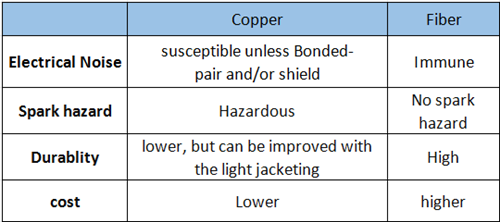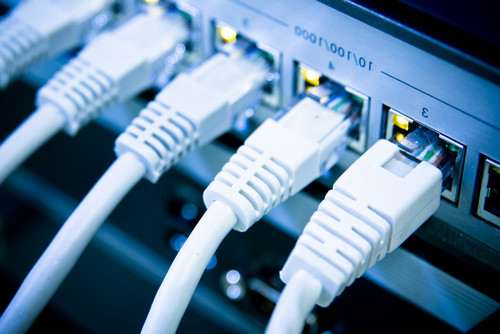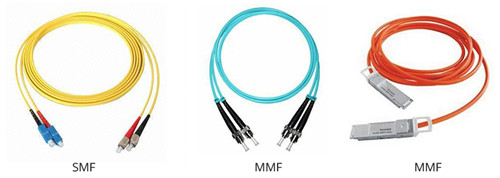The Reality of Copper and Fiber Cable
The war between copper and fiber has been raged for years and it is never ended. Copper-based systems maintain the same upgrade path that they have for years, while fiber-optic proponents continue to advocate their sense of superiority, which forces people to face the dilemma of selecting copper or optical fiber. So, once again, which cabling type is the best overall value for their current and projected future needs? This article carefully looks into the question and gives you the reality of the present copper and fiber cables.
Major Difference Between Copper and Optical Fiber
Cable length and data rates are two of the key criteria that differentiate the use of copper or fiber optic cable. If you require a long link length and high data rate, then fiber cable may be the obvious choice, and you can move on to selecting a specific fiber cable. Alternatively, if the runs are short and the data volume fits within copper's capacity, then copper it is. Some other general differences between copper and fiber optic cables are offered in the table. Once you understand the distinct properties of copper and fiber, your solution may seem clearer. Now let’s come to the reality of both cables to help you select the suitable one.

Copper Cabling in Gigabit Ethernet Application
Category 6 or Cat6 data cabling as one of the most popular copper cables in the market today, has been utilized for Gigabit Ethernet and several other network protocols. As the sixth generation Ethernet cables formed from twisted pairs of copper wiring, cat6 is composed of four pairs of wires, similar to cat5 cables. The primary difference between the two, though, is that cat6 makes full use of all four pairs. This is why cat6 can support communications at more than twice the speed of cat5e, allowing for Gigabit Ethernet speeds of up to 1 gigabit per second.

However, there are some link restrictions in using this type of data cabling. When used for 10/100/1000BASE-T, the restriction of the copper cable is 100 meters, and when used for 10GBASE-T, the restriction is 55 meters. Another issue is that there are some cat6 cables that are very large and are quite difficult to connect to 8P8C connectors (a type of modular connector used for communications purposes such as phone/Ethernet jacks) when the user does not have a unique modular piece.
Copper cable still has a place in the telecom field, the best prove is that copper cable has improved itself to face the ever-increasing bandwidth requirement. For 40G Ethernet, there are 40G DAC cables — passive copper cable or active copper cable available in the market to achieve 40G connectivity. For example, Cisco QSFP to QSFP+ copper cables, like QSFP-H40G-CU1M and QSFP-H40G-ACU7M are widely used to connect within racks and across adjacent racks.
Fiber Optic Cabling
Fiber optic cable is completely unique from cat6 and other types of copper cabling systems. The most obvious feature about optical fiber is that it draws on light instead of electricity to transmit signals. In addition, optical fiber is immune to electrical interference, which means that a user can run it just about anywhere, anytime. However, fiber is not that easy to install. Terminating fiber optic cable is not as simple as copper. While manufacturers have developed crimp-on connectors, they are expensive, high loss and have not been very reliable. Fiber optic connectors need adhesives for reliability and low cost. And most installation involves stripping fibers, injecting adhesives and polishing the ends. No IDC (insulation displacement connectors) here. Any good installer can learn how to terminate fiber in less than 2 hours. The following picture shows a singlemode and multiomde optic cable.

Not all fibers have infinite bandwidth. At least not the multimode fiber used in most premises networks. It's a lot higher than copper, but as you approach gigabit speeds, you are limiting the distances available for links to 500 meters or so. Singlemode fiber, as used in telecom and CATV networks, practically has infinite bandwidth. But it uses higher cost components and can be pricey for shorter links. It's not necessary for today's networks but may be for the next generation. Well, fiber prices continue to fall while copper prices rise.
Know Your Application, Then Select Your Cable
Just as knowing it’s vital to select the right switches, routers and firewalls for an industrial Ethernet network, it is also vital to select the right cable. When it comes to industrial Ethernet cable, long reach and high data volumes call for fiber cable. For short runs and average data requirements, copper cable will do the job. Next consider the operating environment and mechanical devices will face to help you on a final choice. Fiberstore provides various copper cables and fiber cables, including OM3 cable, OM4 cable, Cat6A copper cable, Cat5A copper cable and other specific cables. 40G DACs and AOCs are also offered. You won;t miss it.